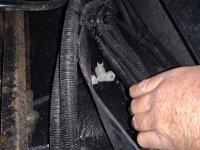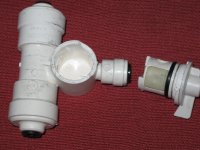This morning we woke up to pump groaning and water running this is the second time that has broken after a freeze. My question is why is this fridge "T" valve exposed.. prone to the weather?
Den.
First, the drain valve is an idea that someone at Heartland came up with when they started offering Residential Refrigerators. The idea was to make it easy for you to drain the water feed line to the refrigerator. When we were collecting information for the
Residential Refrigerator User Guide, some of us tested this out on an early unit and found it ineffective.
Second, before Residential Refrigerators, when refrigerators started getting located in slideouts, that created a problem with routing of the water feed line. In most builds, the feed line is routed into the slide through the floor. So a portion of the 1/4" poly tubing is located under the slide where it's exposed to outside air.
If there's water in the line, and outside temperatures drop below freezing, you're likely to have damage to the feed line, and to the drain valve with Residential Refrigerators.
Some people suggest adding insulation, but I don't think that will give you more than a little protection as insulation slows, but doesn't prevent heat transfer.
Some people have changed out the 1/4" poly tubing for a stronger tubing reinforced with metal braiding. Haven't heard any complaints from those who did, so maybe those lines survive a hard freeze.
On our 2011, the water feed line to the fridge starts in the basement plumbing area and is routed outside and through the floor of the kitchen slide. I also got tired of winterizing the water feed line and just stopped using the ice maker and water dispenser.


